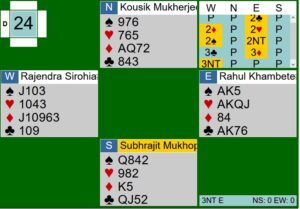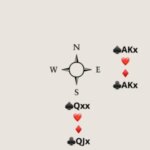Priya Balasubramanian
Recently, when I grudgingly attended a mandatory workshop at my son’s school, I had a moment of realization.
They showed us a video where a diehard cyclist is given the challenge of riding a cycle whose handles had been engineered to move in the reverse direction as compared to a regular cycle. So, if you turn the handle left, you go right and vice versa. It took him 8 hard months to master this bike.
This says something important. Knowledge is not learning. It is never so true as in Bridge. A significant revelation in my albeit short period of playing bridge is this: What makes an expert is not the ability to execute an exotic squeeze but the stamina to do the hard grind at every single deal.
It is not the books you read but the application at the table that matters. A top player I am told, memorizes probable card distributions every single day, giving him the edge and speed that sets him apart.
A hand that exemplifies this was played in the VS Gangal Match point pairs Elimination. The hand and the bidding is as below.
What does South know? East has turned up with 22-24 points, say 23 - his partner has  taken him to game. So, North can have a max of 6-7 points. The 3♣ bid is Puppet Stayman and the 3♦ by East promises one or more majors. West’s sign off in 3N indicates he was looking for a five-card major with East, so West may have 3 cards in one or both major. East has at least one 4-card major. Leading from honors sitting above the strong hand could give away an unnecessary trick so South goes passive and leads a heart.
taken him to game. So, North can have a max of 6-7 points. The 3♣ bid is Puppet Stayman and the 3♦ by East promises one or more majors. West’s sign off in 3N indicates he was looking for a five-card major with East, so West may have 3 cards in one or both major. East has at least one 4-card major. Leading from honors sitting above the strong hand could give away an unnecessary trick so South goes passive and leads a heart.
East, the declarer: He has eight top tricks. A spade lead or a club lead would have solved his problems. He cashes his 4 hearts to further understand the hand. Whilst he cashes North encourages Diamonds and South spades. He exits with a diamond.
South wins the K♦ and duly following partner’s signals returns a diamond. North cashes A♦ & Q♦ and returns a spade to partner. The declarer goes up with the A♠ and then plays the A♣.
To use a favorite phrase from my MBA times :"What should South do and why?"

If South had been applying himself at the table, he would know the following.
-
-
- All the high card points are now with the declarer. He has K♠, A♣ and K♣.
-
- Declarer’s shape is either 4-4-2-3 or 3-4-2-4.
- It is unlikely his shape is 4-4-2-3 else he would duck the spade.
- The spot cards in clubs in the dummy are 10and 9.
- A throw in is looming and he may be forced to lead away from Q♠.
This is the end position which South should be envisaging. To prevent the throw in, he must unblock his clubs now.
When declarer plays the A♣ and K♣ he unblocks his Q and J under them hoping for his partner to have the 8♣. If declarer has the 8, then he must make his contract anyway.

It is this rigor of constant counting and watching the spot cards that gets rewarded at every deal. I leave you with a quote from Bob Hamman.
Special thanks to Rahul Khambete for bringing this deal to my attention.
Special thanks to Subhash Bhavnani for the technical edit.
Disclaimer : All opinions are entirely those of the author and are no reflection of the views of the BridgeFromHome Team.

Well written piece especially with regards to the difference between knowledge and learning.
Would like to know how a C lead would solve declares problems in the given layout? C Queen lead would be equally effective.
Club Q lead would be effective if you again unblocked the J. Here I meant the standard lead of 4th best
Thank you
Very well written and to good analysis.
Thanks
Interesting hand, and well written, too.
Very nice hand and commentary.